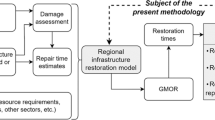Abstract
Technology is the motor of human progress, but it moves slowly. Recent advances in hydrology may not be adopted in practice. We need to assess why and what can be done. A model is a set of equations organized for rapid computation in linked systems of spatial and linear transforms. Model assessments can help decision makers in facility, operations, and nonstructural planning; but planner response is limited by organizational structure, laws and policies, politics, and pressure groups. Thus, hydrologic modeling is an institutional process. Acceptance requires good credentials, understandability, and validity. Models are expected to convey facts, answer doubts, and be readily updated. They should free time for professional reflection. Modelers should state explicit goals to reduce model misuse and track the many interactions among large numbers of alternatives. Then institutions would accept them more readily.
Access this chapter
Tax calculation will be finalised at checkout
Purchases are for personal use only
Preview
Unable to display preview. Download preview PDF.
Similar content being viewed by others
References
Bonnin, J.: 1988, ‘Were Urban Water Systems Improved Over the Last 20 Centuries?,’ Water International 13(1), 13–16.
Burges, S. J.: 1986, ‘Trends and Directions in Hydrology,’ Water Resources Research 22(9), 1S–5S.
Brutsaert, W.: 1986, ‘Catchment-Scale Evaporation and the Atmospheric Boundary Layer,’ Water Resources Research 22(9), 39S–45S.
Dooge, J. C. I.: 1986, ‘Looking for Hydrologic Laws,’ Water Resources Research 22(9), 46S–58S.
Eagleson, P. S.: 1986, ‘The Emergence of Global-Scale Hydrology,’ Water Resources Research 22(9), 6S–14S.
Fox, I. K.: 1975, ‘Strategic Considerations in Attaining Water Resources Planning Goals,’ Selected Works in Water Resources, International Water Association, pp. 231–239.
Gleick, J.: 1987, Chaos: Making a New Science, New York: Viking.
Grigg, N. S.: 1985, Water Resources Planning, McGraw-Hill Book Company.
Gupta, V. K., I. Rodriguez-Iturbe, and E. F Wood: 1986, Scale Problems in Hydrology.
Hamilton, A. L.: 1974, ‘Organizational Impediments to Effective Environmental Impact Research,’ in Agassiz Center for Water Studies, The Allocative Conflicts in Water-Resource Management, Winnipeg, pp. 391–403.
Howe, C. W.: 1971, ‘Benefit-Cost Analysis for Water System Planning,’ American Geophysical Union, Washington, D.C.
James, L. D., and P. Caswell: Under preparation, ‘From Construction to Resource Management: The Evolution of Irrigation Institutions.’
Klemes, V: 1986, ‘Dilettantism in Hydrology: Transition or Destiny?,’ Water Resources Research 22(9), 177S–188S, August 1986.
Linsley, R. K.: 1986, ‘Flood Estimates: How Good Are They?,’ Water Resources Research 22(9), 159S–164S.
Loucks, D. P., J. R. Stedinger, and D. A. Haith: 1981, Water Resources Systems Planning and Analysis.
Maass, A., et al.: 1962, Design of Water-Resources Systems,Cambridge, Mass.: Harvard University Press.
Mandelbrot, B. B.: 1983, The Practical Geometry of Nature, W.W. Freman and Co., N.Y.
McVicker, R. R.: 1982, ‘The Effects of Model Complexity on the Predictive Accuracy of Soil Moisture Accounting Models,’ Utah State University, Logan, Utah.
Mesthene, E. G.: 1970, Technological Change: Its Impact on Man and Society,Harvard University Press, Cambridge, Mass.
National Water Policy: 1987, Government of India, Central Water Commission, New Delhi.
Office of Technology Assessment: 1982, Use of Models for Water Resources Management Planning and Policy, Washington, DC.
Pilgrim, D.H.: 1986, ‘Bridging the Gap Between Flood Research and Design Practice,’ Water Resources Research 22(9), 165S–176S.
Renard, K. G., W. J. Rawls, and M. M. Fogel: 1982, Currently Available Models. Hydrologic Modeling of Small Watersheds.
Rodriguez-Iturbe, I.: 1986, ‘Scale of Fluctuation of Rainfall Models,’ Water Resources Research 22(9), 15S–37S.
Rogers, P. P., and M. B. Fiering: 1986, ‘Use of Systems Analysis in Water Management,’ Water Resources Research 22(9), 146S–158S.
Sambongi, K.: 1988, ‘Characteristics and Functions of Water Institutions,’ Water Resources Development 4(1), 53–57.
Sklash, M. G., I. D. Moore, and G. J. Burch: 1988, Environmental Isotope Tracer Studies of Catchment Processes: Tools for Verifying Integrated Water Quality Models.
Author information
Authors and Affiliations
Editor information
Editors and Affiliations
Rights and permissions
Copyright information
© 1991 Springer Science+Business Media Dordrecht
About this chapter
Cite this chapter
James, L.D. (1991). Hydrologic Modeling for Water Resources Planning. In: Bowles, D.S., O’Connell, P.E. (eds) Recent Advances in the Modeling of Hydrologic Systems. NATO ASI Series, vol 345. Springer, Dordrecht. https://doi.org/10.1007/978-94-011-3480-4_26
Download citation
DOI: https://doi.org/10.1007/978-94-011-3480-4_26
Publisher Name: Springer, Dordrecht
Print ISBN: 978-94-010-5538-3
Online ISBN: 978-94-011-3480-4
eBook Packages: Springer Book Archive




